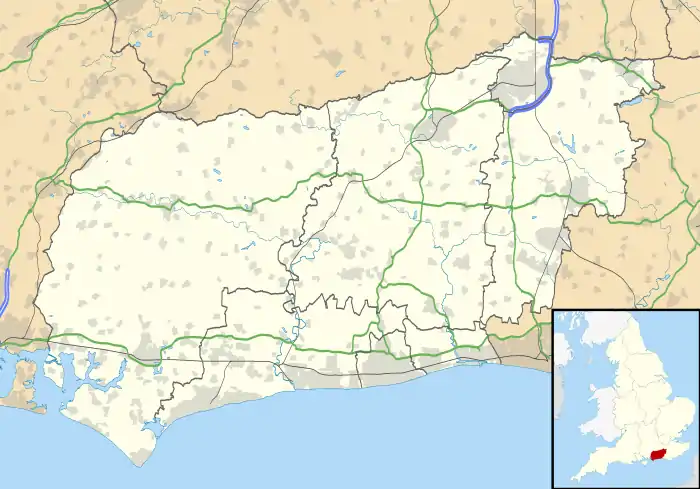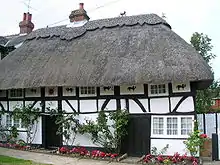Henfield
Henfield is a large village and civil parish in the Horsham District of West Sussex, England. It lies 33 miles (53 km) south of London, 12 miles (19 km) northwest of Brighton, and 30 miles (48 km) east northeast of the county town of Chichester at the road junction of the A281 and A2037. The parish has a land area of 4,285 acres (1,734.1 ha). In the 2001 census 5,012 people lived in 2,153 households, of whom 2,361 were economically active. Other nearby towns include Burgess Hill to the east and Shoreham-by-Sea to the south. The population at the 2011 Census was 5,349.[2]
| Henfield | |
|---|---|
 Henfield from the air | |
 Henfield Location within West Sussex | |
| Area | 17.35 km2 (6.70 sq mi) [1] |
| Population | 5,012 [1] 2001 Census 5,349 (2011 Census)[2] |
| • Density | 289/km2 (750/sq mi) |
| OS grid reference | TQ215162 |
| • London | 40 miles (64 km) N |
| Civil parish |
|
| District | |
| Shire county | |
| Region | |
| Country | England |
| Sovereign state | United Kingdom |
| Post town | HENFIELD |
| Postcode district | BN5 |
| Dialling code | 01273 |
| Police | Sussex |
| Fire | West Sussex |
| Ambulance | South East Coast |
| UK Parliament | |
| Website | Parish Council |
| Arms of Henfield Parish Council | |
|---|---|
| Crest | On a Wreath Argent and Gules upon the top of a Thorn Bush a Golden Oriole wings displayed and addorsed grasping with the dexter claw a Sprig of Thorn issuing from the bush and fructed at the top with two Berries all proper. |
| Blazon | Argent on a Bend cottised between in chief two Keys in saltire the bows downward tied by a Cord and in base a Pelican in her Piety Gules three Bezants. |
| Motto | Domine Salva Nos (Lord Save Us) |
| Granted on 10 February 1992.[3] | |
Just west of the town, the two branches of the River Adur, the western Adur and the eastern Adur, meet at Betley Bridge. From Henfield the Adur flows on into the English Channel at Shoreham-by-Sea.[4]
Henfield was already a large village, of 52 households, at the time of Domesday (1086).[5]
Facilities

One of the largest village communities in the Horsham district, Henfield has an old and attractive centre.
It has a modern and intensely used village hall just off the High Street, the 13th-century St Peter's church, old inns, a wide and attractive common, and many interesting houses in private ownership.
There is a fire station, part of the West Sussex Fire Brigade, equipped with a single fire engine.
Henfield has one of the oldest cricket clubs in the world, dating back to 1771. A womens team was formed from 2006.[6]
Henfield also officially has the oldest Scout group in the country (1st Henfield), dating from 1907. When officially registered in 1908 there were 36 scouts in the group. The group was started in winter 1907-8 by Audrey Wade, whose brother, A. G. Wade, had met Baden-Powell when both were travelling to the UK from Africa when they were in the army. A. G. Wade later had several administrative roles in the developing Scout movement.[7]
To the south is Woods Mill, a restored mill, now the headquarters of the Sussex Wildlife Trust, its attractions including an extensive nature trail.
There is also a theatre company which is held in the village hall.
Sports facilities
Henfield Leisure Centre at Northcroft has a sports hall and fitness suite. There is a small skate park located next to the sports centre. Near to the leisure centre is Henfield tennis club, founded in 1920.[8]
The Cat House

The Cat House is at Pinchnose Green, so called because there used to be a tannery nearby and the process of tanning produces unpleasant odours. This house was once owned by George Ward who had a canary. This bird was killed by a cat belonging to the Anglican Canon Nathaniel Woodard who lived at nearby Martyn Lodge. So incensed was Ward that he painted his house with pictures of a cat holding a bird that would be seen by the canon every time he walked past on his way to the church. He also rigged up strings of sea shells to rattle, and a black figure would appear at a small window called the zulu hole when the hapless canon was seen approaching.
Henfield Museum
Started in the 1930s, Henfield Museum moved to its current location in the Henfield Hall in 1974. It contains collections related to local events and people from mesolithic times onwards as well as local natural history. It also contains materials linked to local people such as Marjorie Baker and William Borrer and enterprises including the Allen-Brown Violet Nurseries and local railway station (closed in 1966).[9] It is run by the Friends of Henfield Museum and the Henfield Parish Council.
History
Henfield was the home of Colonel Henry Bishop, who was appointed Postmaster General by King Charles II in January 1660–61. Bishop devised the first type of postmark used in England, which is known to collectors as a Bishop mark. His invention was commemorated in 1963, on the occasion of an exhibition by Henfield Stamp Club. A special date stamp, which included the wording HENRY BISHOP'S VILLAGE, was used. Bishop is buried in Henfield churchyard.
The eighteenth century botanist William Borrer, who specialised in the flora of the British Isles, was born and died in Henfield.[10]
When the British government introduced the Cat and Mouse Act in 1913, local Suffragette Elizabeth Robins used her 15th century farmhouse at Backsettown, near Henfield, that she shared with Octavia Wilberforce, as a retreat for suffragettes recovering from hunger strike.[11]
References
- "2001 Census: West Sussex – Population by Parish" (PDF). West Sussex County Council. Archived from the original (PDF) on 8 June 2011. Retrieved 12 April 2009.
- "Civil Parish population 2011". Neighbourhood Statistics. Office for National Statistics. Archived from the original on 21 October 2016. Retrieved 30 September 2016.
- "HENFIELD PARISH COUNCIL (W SUSSEX)". Robert Young. Archived from the original on 22 January 2021. Retrieved 31 October 2019.
- "Archived copy". Archived from the original on 8 September 2008. Retrieved 7 August 2008.CS1 maint: archived copy as title (link)
- Domesday on-line: Henfield Archived 27 August 2017 at the Wayback Machine.
- "Henfield Cricket Club History". Henfield Cricket Club. Archived from the original on 23 January 2021. Retrieved 15 September 2020.
- "Scouts 1st Henfield - History". Archived from the original on 23 January 2021. Retrieved 15 September 2020.
- "Henfield Tennis Club". Archived from the original on 22 September 2020. Retrieved 15 September 2020.
- Gordon, R. S. "Henfield Museum". Archived from the original on 15 August 2020. Retrieved 15 September 2020.
- Kell, P. E. (2004). "Borrer, William (1781–1862)". Oxford Dictionary of National Biography (online ed.). Oxford University Press. doi:10.1093/ref:odnb/2917. (Subscription or UK public library membership required.)
- "Archived copy". Archived from the original on 14 January 2012. Retrieved 14 February 2012.CS1 maint: archived copy as title (link)